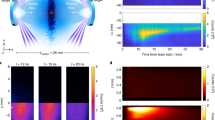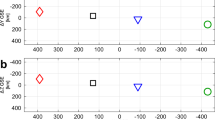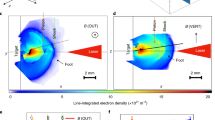Abstract
The Sun’s active corona requires an energy flux of ~103 W m−2 to compensate for radiative losses and to maintain its high temperature1. Plasma moves in the corona through magnetic loops2,3, which may be connected with the flows in and around sunspots4,5,6. Global energizing processes (for example, reconnection) play an important part in heating the corona7,8,9; however, energy and mass transport may also occur via shocks, waves or flows5,10,11. A full picture and the influence of such localized events, which significantly couple with various layers of the solar upper atmosphere, is still not clear. Using the Interface Region Imaging Spectrograph temporal image data of C ii 1,330 Å, we observed the presence of pseudo-shocks around a sunspot. Unlike shocks12, pseudo-shocks exhibit discontinuities only in the mass density. A two-fluid numerical simulation reproduces such confined pseudo-shocks with rarefied plasma regions lagging behind them. We find that these pseudo-shocks carry an energy of ~103 W m−2, which is enough to locally power the inner corona and also generate bulk flows (~10−5 kg m−2 s−1), contributing to the localized mass transport. If they are ubiquitous, such energized and bulky pseudo-shocks above active regions could provide an important contribution to the heating and mass transport in the overlying solar corona.
This is a preview of subscription content, access via your institution
Access options
Access Nature and 54 other Nature Portfolio journals
Get Nature+, our best-value online-access subscription
$29.99 / 30 days
cancel any time
Subscribe to this journal
Receive 12 digital issues and online access to articles
$119.00 per year
only $9.92 per issue
Buy this article
- Purchase on Springer Link
- Instant access to full article PDF
Prices may be subject to local taxes which are calculated during checkout




Similar content being viewed by others
Data availability
The data that support the plots within this paper and other findings of this study are available from the corresponding author upon reasonable request.
References
Withbroe, G. L. & Noyes, R. W. Mass and energy flow in the solar chromosphere and corona. Annu. Rev. Astron. Astrophys. 15, 363–387 (1977).
Feldman, U., Landi, E. & Schwadron, N. A. On the sources of fast and slow solar wind. J. Geophys. Res. 110, A07109 (2005).
Harra, L. K. et al. Outflows at the edges of active regions: contribution to solar wind formation? Astrophys. J. 676, L147–L150 (2008).
Katsukawa, Y. et al. Small-scale jetlike features in penumbral chromospheres. Science 318, 1594–1597 (2007).
Vissers, G. J. M., Rouppe van der Voort, L. H. M. & Carlsson, M. Evidence for a transition region response to penumbral microjets in sunspots. Astrophys. J. 811, 33–38 (2015).
Tiwari, S. K., Moore, R. L., Winebarger, A. R. & Alpert, S. E. Transition-region/coronal signatures and magnetic setting of sunspot penumbral jets: Hinode (SOT/FG), Hi-C, and SDO/AIA observations. Astrophys. J. 816, 92 (2016).
Cargill, P. J. & Klimchuk, J. A. Nanoflare heating of the corona revisited. Astrophys. J. 605, 911–920 (2004).
Aschwanden, M. J., Winebarger, A., Tsiklauri, D. & Peter, H. The coronal heating paradox. Astrophys. J. 659, 1673–1681 (2007).
Klimchuk, J. A. Key aspects of coronal heating. Phil. Trans. R. Soc. A 373, 20140256 (2015).
Ryutova, M., Berger, T., Frank, Z. & Title, A. On the penumbral jetlike features and chromospheric bow shocks. Astrophys. J. 686, 1404–1419 (2008).
Bharti, L., Solanki, S. K. & Hirzberger, J. Lambda-shaped jets from a penumbral intrusion into a sunspot umbra: a possibility for magnetic reconnection. Astron. Astrophys. 597, A127 (2017).
Priest, E. R. Magnetohydrodynamics of the Sun (Cambridge Univ. Press, Cambridge, 2014).
Crocco, L. in High Speed Aerodynamics and Jet Propulsion: Fundamentals of Gas Dynamics Vol III (ed. Emmons, H. W.) 110–130 (Princeton Univ. Press, Princeton, 1958).
De Pontieu, B. et al. The interface region imaging spectrograph (IRIS). Sol. Phys. 289, 2733–2779 (2014).
De Pontieu, B. et al. On the prevalence of small-scale twist in the solar chromosphere and transition region. Science 346, 1255732 (2014).
Wójcik, D. P. Numerical Model of Magnetohydrodynamic Waves in the Solar Atmosphere. MSc thesis, Maria Curie-Skłodowska Univ. (2016).
Konkol, P., Murawski, K. & Zaqarashvili, T. V. Numerical simulations of magnetoacoustic oscillations in a gravitationally stratified solar corona. Astron. Astrophys. 537, A96 (2012).
Avrett, E. H. & Loeser, R. Models of the solar chromosphere and transition region from SUMER and HRTS observations: formation of the extreme-ultraviolet spectrum of hydrogen, carbon, and oxygen. Astrophys. J. Suppl. 175, 229–276 (2008).
Kuźma, B. et al. 2-fluid numerical simulations of solar spicules. Astrophys. J. 849, 78 (2017).
Oliver, R., Soler, R., Terradas, J. & Zaqarashvili, T. V. Dynamics of coronal rain and descending plasma blobs in solar prominences. II. Partially ionized case. Astrophys. J. 818, 128 (2016).
Khomenko, E. On the effects of ion-neutral interactions in solar plasmas. Plasma Phys. Contr. Fusion 59, 014038 (2017).
Edwards, S. J., Parnell, C. E., Harra, L. K., Culhane, J. L. & Brooks, D. H. A comparison of global magnetic field skeletons and active-region upflows. Sol. Phys. 291, 117–142 (2016).
Jess, D. et al. Alfvén waves in the lower solar atmosphere. Science 323, 1582–1585 (2009).
McIntosh, S. et al. Alfvénic waves with sufficient energy to power the quiet solar corona and fast solar wind. Nature 475, 477–480 (2011).
Srivastava, A. K. et al. High-frequency torsional Alfvén waves as an energy source for coronal heating. Sci. Rep. 7, 43147 (2017).
Cirtain, J. W. et al. Energy release in the solar corona from spatially resolved magnetic braids. Nature 493, 501–503 (2013).
Yang, S., Zhang, J., Jiang, F. & Xiang, Y. Oscillating light wall above a sunspot light bridge. Astrophys. J. 804, L27 (2015).
Tian, H. et al. Observations of subarcsecond bright dots in the transition region above sunspots with the interface region imaging spectrograph. Astrophys. J. 790, L29 (2014).
Alpert, S. E., Tiwari, S. K., Moore, R. L., Winebarger, A. R. & Savage, S. L. Hi-C observations of sunspot penumbral bright dots. Astrophys. J. 822, 35 (2016).
Acknowledgements
A.K.S. and B.N.D. acknowledge the RESPOND-ISRO (DOS/PAOGIA205-16/130/602) project. A.K.S. acknowledges the SERB-DST project (YSS/2015/000621) grant, and the Advanced Solar Computational and Analyses Laboratory (ASCAL). Armagh Observatory and Planetarium is grant-aided by the Northern Ireland Department for Communities. J.G.D. acknowledges the DJEI/DES/SFI/HEA Irish Centre for High-End Computing for provision of computing facilities and support. J.G.D. also thanks the STFC for PATT travel and subsistence and the SOLARNET project, which is supported by the European Commission’s FP7 Capacities Programme under grant agreement number 312495, for travel and subsistence. M.S. acknowledges support from ‘Progetti di ricerca INAF di Rilevante Interesse Nazionale’ (PRIN-INAF 2014) and project 2012P2HRCR ‘Il sole attivo ed i suoi effetti sul clima dello spazio e della terra’ (PRIN MIUR 2012) grants, funded by the Italian National Institute for Astrophysics (INAF) and Ministry of Education, Universities and Research (MIUR), respectively. Work by K.M., B.K. and D.P.W. was supported financially by projects at the National Science Centre, Poland (grant numbers 2014/15/B/ST9/00106 and 2017/25/B/ST9/00506). T.V.Z. was supported by the Austrian Science Fund ‘FWF’ project P30695-N27 and Georgian Shota Rustaveli National Science Foundation project DI-2016-17. Z.E.M. acknowledges support from the Alexander von Humboldt Foundation. The authors express thanks to A. Kaczmarczyk for assistance with creating the Adobe illustrations. They also acknowledge the use of IRIS and Solar Dynamics Observatory/Atmospheric Imaging Assembly observations in this work.
Author information
Authors and Affiliations
Contributions
A.K.S. led the project by defining the novel science case, analysing and making the IRIS observations, and writing the paper. K.M., B.K. and D.P.W. constructed the numerical model based on the two-fluid JOANNA code, which was developed by D.P.W. All co-authors (A.K.S., K.M., B.N.D., J.G.D., T.V.Z., M.S., Z.E.M., B.K., D.P.W. and P.K.) participated in studying the science and editing the draft.
Corresponding author
Ethics declarations
Competing interests
The authors declare no competing interests.
Additional information
Publisher's note: Springer Nature remains neutral with regard to jurisdictional claims in published maps and institutional affiliations.
Supplementary information
Supplementary Information
Supplementary Table 1, Supplementary Text, Supplementary Figures 1–4, captions of Supplementary Videos 1–11
Rights and permissions
About this article
Cite this article
Srivastava, A.K., Murawski, K., Kuźma, B. et al. Confined pseudo-shocks as an energy source for the active solar corona. Nat Astron 2, 951–956 (2018). https://doi.org/10.1038/s41550-018-0590-1
Received:
Accepted:
Published:
Issue Date:
DOI: https://doi.org/10.1038/s41550-018-0590-1
This article is cited by
-
Transverse oscillations and an energy source in a strongly magnetized sunspot
Nature Astronomy (2023)
-
Two-fluid numerical model of chromospheric heating and plasma outflows in a quiet-Sun
Astrophysics and Space Science (2022)
-
Period dependence of physical quantities of slow magnetoacoustic waves in coronal loop structures of active regions with and without sunspots
Journal of Astrophysics and Astronomy (2021)
-
A New View of the Solar Interface Region from the Interface Region Imaging Spectrograph (IRIS)
Solar Physics (2021)
-
Longitudinal Plasma Motions Generated by Shear Alfvén Waves in Plasma with Thermal Misbalance
Solar Physics (2021)



